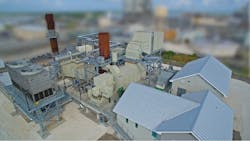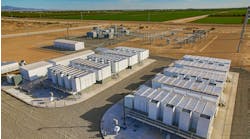Movement is afoot worldwide to bring new intelligence to conventional or ‘dumb’ generation. Gas turbine microgrids are central to this smartening of power generation.
Courtesy of Solar Turbines
The term dumb generation describes the kind of conventional power plants, wind turbines or solar panels that have been used for decades. They produce megawatts, but do nothing more.
In contrast, intelligent generation systems not only produce megawatts, but also determine how and when to apply the megawatts to achieve a specific effect. The generators gain this intelligence via software controllers.
Such intelligence is at the heart of the contemporary microgrid. It offers a way to derive maximum efficiency and cost savings from energy production while lowering emissions.
In our new guide, “Gas Turbine Microgrids: Reliability and Sustainability through Intelligence,” we look at several ways gas turbines contribute to the intelligent functioning of microgrids. We describe how they act as the backbone or anchor for system efficiency, particularly when paired with renewable energy. We feature real-world examples of gas turbine microgrids in North America, Europe and Australia.
Why gas turbine microgrids
Converging market and societal forces make this the age of gas turbine microgrids.
More than half of the microgrids planned in North America intend to use some form of gas, according to a 3Q2016 microgrid report by GTM Research.
Why?
First, natural gas is plentiful and its pricing has remained historically low in the United States, the fastest growing market for microgrids.
Gas Turbine Microgrid Special Report – Download Now
Download the full report, Gas Turbine Microgrids: Reliability and Sustainability through Intelligence
Second, gas generation is an effective companion to the growing amount of renewable energy that utilities and others are adding to power grids worldwide. When passing clouds halt solar generation or the wind ceases to move wind turbines, gas turbines instantaneously ramp up to keep the electricity flowing.
Third, gas offers a sounder environmental choice than coal or oil-fired generation. Natural gas produces less carbon emissions. Biogas is even better from an emissions standpoint. It offers a 100 percent renewable, carbon footprint free fuel that channels landfill and agricultural emissions to good use.
Fourth, natural gas is typically transported below ground, making it less vulnerable to storms and supply disruptions due to road closures that are common during major grid interruptions.
“The gas turbine is the anchor of many microgrids,” said Daniel Fingleton, program manager for strategic growth and special projects at Solar Turbines. “If the plant has the ability to island, which essentially makes it a microgrid, the gas turbine is a critical part. It is key to load control, frequency control, voltage control. It is the heart behind the microgrid. ”
“The gas turbine is the anchor of many microgrids,” said Daniel Fingleton, Solar Turbines.
Courtesy of Solar Turbines
Pairing CHP and renewables
Many of these gas turbine microgrids employ combined heat and power (CHP) systems. A highly efficient, clean technology, CHP is especially common in microgrids that serve colleges, hospitals, the military, industrial plants or others that need not only electricity but also large amounts of heat, hot water or steam.
More than half of the CHP plants in the U.S. use gas, according to the U.S. Department of Energy. This may be natural gas or a renewable form of gas, such as digester gas, landfill gas and gasified biomass or municipal solid waste.
Also called cogeneration, CHP is often extolled for its two-for-one fuel advantage. CHP derives twice as much energy from the same amount of fuel as does a conventional power plant. It does this by using the waste heat created in generating electricity. The heat would otherwise be discarded. But instead the waste heat may be used for a variety of purposes, such as heating buildings, warming water, powering industrial processes as steam, or providing air conditioning via an absorption chiller or steam turbine-driven chiller.
Electric chillers can be deployed off peak and then the produced chilled water can be stored, allowing a reduction in peak load demand — and providing a way to balance intermittent wind and solar.
It’s particularly interesting to look at how well CHP pairs with renewable energy. The efficiency CHP achieves in this circumstance defies conventional ideas about how gas turbines work. Typically, a gas turbine — one that’s not part of a CHP system — operates at highest efficiency when it is producing the maximum amount of megawatts possible. So, a 15-MW gas turbine, by way of example, most efficiently uses fuel when it produces 15 MW.
But it’s different when the turbine is part of a CHP system. The CHP plant can run at a lower production level, generating less than 15 MW, and still achieve very high efficiencies. This is because in a CHP system the fuel isn’t just producing electricity; it’s also creating usable waste heat that serves buildings within the microgrid’s footprint.
“Most people think that at reduced load a turbine is not efficient. That is a fallacy when it is also serving a thermal load,” said Chris Lyons, power generation program manager at Solar Turbines. “Even if you reduce the output of the gas turbine, the overall efficiency of the CHP plant remains very, very high.”
Why is this important?
Today’s advanced microgrids often include multiple forms of distributed energy. Renewable energy is increasingly one of those forms. When CHP technology is also included in the microgrid, the system becomes highly agile in managing renewable energy intermittency — the problem of a sudden drop off in energy production when the wind doesn’t blow or the sun doesn’t shine.
CHP is especially good at overcoming intermittency by offering what is called spinning reserve — generation that is not used but ready to go at a moment’s notice.
“Consider a scenario where you install a 15-MW gas turbine in a microgrid that also has 4 MW of solar photovoltaics. Say you typically only need 11 MW of generation from the gas turbine. You hold the other 4 MW in reserve as a spinning resource. If a cloud comes over, and your solar panels stop generating, you can instantaneously crank up the gas turbine to make up for the 4 MW loss,” Lyons said.
These microgrids are typically designed so that renewable energy is the first fuel. They will use, for example, the maximum amount of solar generation that the system produces before employing other forms of generation. This makes sense since the sun is a free, and an emission free, fuel.
But solar generation can’t always be counted on, so the gas turbine acts as the backbone of the system, always there and operating and ready to step in to deliver reliable power when the solar energy disappears, due to cloud cover or sunset. Given the efficiency and versatility CHP provides, it’s not surprising that it is used within a large number of grid-connected microgrids.
For example, GTM Research says that CHP accounts for 80 percent of operational university microgrid generation. (For more information on CHP in microgrids, see our earlier white paper, “The Energy Efficient Microgrid.”)
The thinking microgrid
This ability to manage renewable variability is one of several ways microgrids bring intelligence to what would otherwise be dumb generation. The intelligence comes by way of software-driven systems known as microgrid controllers.
Controllers vary in their intelligence. Some provide simple functions such as basic dispatch of heat and electricity use within a microgrid. Others offer highly advanced management. Moment by moment these master controllers continuously configure all of the various resources available to the system—possibly natural gas generators, solar, wind, energy storage, thermal energy, diesel engines, grid power, building load. The controller determines what combination of resources to use, and when, to best meet customer goals. The customer might want to achieve best price, low carbon emissions, high electric reliability, renewable portfolio standards, or some other goal.
The controllers also manage the microgrid’s islanding function, its ability to detect disruption on the central grid and automatically separate itself, so that its customers do not fall victim to a grid power outage. The microgrid then relies on its on-site generation to keep power flowing to local customers. Advanced controllers do this automatically and autonomously, with no human interaction, and no disruption to the customer’s service. The same seamless transition occurs when gas turbine microgrids — or other kinds of microgrids — reconnect to the grid after the power outage ends. The customer is unaware of any change.
About this report
We wrote this report to provide real-world insight into how gas turbine microgrids create reliability and sustainability through intelligence. We believe this report will be especially helpful to universities, hospitals, military facilities, manufacturers and others who are considering installing microgrids. It also offers insight for utilities partnering with customers to develop microgrids, or installing microgrids to help integrate renewables and bolster their distribution systems.
This report will be especially helpful to universities, hospitals, military facilities, manufacturers…
The report is a collaboration of Microgrid Knowledge, the leading microgrid news and information site, and turbine manufacturer Solar Turbines, a Caterpillar subsidiary.
Solar Turbines offers a depth of experience in gas turbine and microgrid installation. The California-based company has installed more than 8,000 generation units worldwide, in various environments, many with islanding capability. Solar Turbines has been at the forefront of incorporating intelligent control into gas turbines. The technology can monitor, control and optimize not only the gas turbines within the microgrid, but also its other generators, equipment and load.
Gas Turbine Microgrids: Reliability and Sustainability through Intelligence is provided as a free download, courtesy of Solar Turbines.







